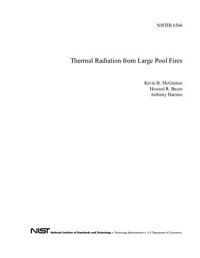
Ebook: Thermal Radiation from Large Pool Fires
- Genre: Technique // Safety and Security
- Tags: Безопасность жизнедеятельности и охрана труда, Пожаровзрывобезопасность
- Language: English
- pdf
National Institute of Standards and Technology (NLST), 2000. — 35 p.This report was developed to be used specifically in implementing the technical requirements
of 24 CFR Part 51, Subpart C of the Code of Federal Regulations, entitled, Siting of HUD-Assisted
Projects Near Hazardous Operations Handling Conventional Fuels or Chemicals of an Explosive
or Flammable Nature. The material contained in this report is for the use of the Department of
Housing and Urban Development (HUD) staff or any other individual, organization or agency
considering the location of HUD-assisted projects near materials of an explosive or flammable
nature. It contains the theoretical development plus the step by step procedures for determining the Acceptable Separation Distance (ASD) for a HUD-assisted project from a specific hazard source.
The acceptable separation distance standards are found in the HUD Regulation at 24 CFR Part 51, Subpart C (paragraph 51.203).
This report addresses primarily the ASD requirements for thermal radiation. Prior to this work,
a calculation procedures for determining ASD was set forth in a 1982 HUD Guidebook entitled,
Urban Development Siting with Respect to Hazardous Commercial/Industrial Facilities [1]. Much
of the theoretical development for the 1982 guidebook is contained in a 1975 HUD Guidebook
entitled Safety considerations in siting housing projects [2]. In the quarter century since these reports were released, the field of fire science has grown rapidly, leading to improved methods of measurement and prediction of fire behavior. A review by the Building and Fire Research Laboratory at the National Institute of Standards and Technology (NIST) of the 1975 HUD guidelines for thermal radiation flux has revealed that for certain fire scenarios the methodology can produce estimates of radiation flux that are up to an order of magnitude larger than those actually measured in field experiments. The principal reason for this discrepancy is the assumption that large fires are unobscured by smoke, that is, a person watching the fire from a distance sees the entire extent of the combustion region. In reality, large fires of most combustible liquids and gases generate an appreciable amount of smoke that shields much of the thermal radiation from striking nearby structures or people.
In this report, a new methodology for computing thermal radiation flux from large fires of
combustible liquids and gases is put forth. The methodology is similar to that described in the
1975 HUD guidelines, but contains improved estimates of fire size and radiant intensity.
of 24 CFR Part 51, Subpart C of the Code of Federal Regulations, entitled, Siting of HUD-Assisted
Projects Near Hazardous Operations Handling Conventional Fuels or Chemicals of an Explosive
or Flammable Nature. The material contained in this report is for the use of the Department of
Housing and Urban Development (HUD) staff or any other individual, organization or agency
considering the location of HUD-assisted projects near materials of an explosive or flammable
nature. It contains the theoretical development plus the step by step procedures for determining the Acceptable Separation Distance (ASD) for a HUD-assisted project from a specific hazard source.
The acceptable separation distance standards are found in the HUD Regulation at 24 CFR Part 51, Subpart C (paragraph 51.203).
This report addresses primarily the ASD requirements for thermal radiation. Prior to this work,
a calculation procedures for determining ASD was set forth in a 1982 HUD Guidebook entitled,
Urban Development Siting with Respect to Hazardous Commercial/Industrial Facilities [1]. Much
of the theoretical development for the 1982 guidebook is contained in a 1975 HUD Guidebook
entitled Safety considerations in siting housing projects [2]. In the quarter century since these reports were released, the field of fire science has grown rapidly, leading to improved methods of measurement and prediction of fire behavior. A review by the Building and Fire Research Laboratory at the National Institute of Standards and Technology (NIST) of the 1975 HUD guidelines for thermal radiation flux has revealed that for certain fire scenarios the methodology can produce estimates of radiation flux that are up to an order of magnitude larger than those actually measured in field experiments. The principal reason for this discrepancy is the assumption that large fires are unobscured by smoke, that is, a person watching the fire from a distance sees the entire extent of the combustion region. In reality, large fires of most combustible liquids and gases generate an appreciable amount of smoke that shields much of the thermal radiation from striking nearby structures or people.
In this report, a new methodology for computing thermal radiation flux from large fires of
combustible liquids and gases is put forth. The methodology is similar to that described in the
1975 HUD guidelines, but contains improved estimates of fire size and radiant intensity.
Download the book Thermal Radiation from Large Pool Fires for free or read online
Continue reading on any device:

Last viewed books
Related books
{related-news}
Comments (0)